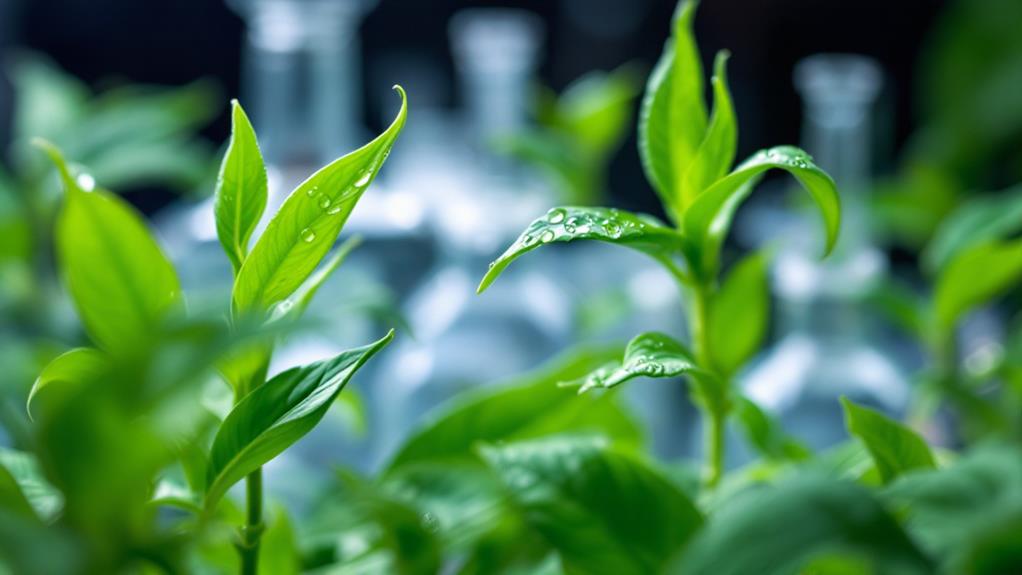Plant growth regulators (PGRs) are powerful tools that can transform your approach to plant cultivation. They're natural or synthetic compounds that influence various aspects of plant growth and development. You'll find five main types: auxins, cytokinins, gibberellins, abscisic acid, and ethylene. Each type has specific functions, from promoting cell elongation to regulating stress responses. In agriculture and horticulture, PGRs offer precise control over crop yields, fruit production, and ornamental plant appearance. They're also valuable in forestry and turf management. By understanding these regulators, you'll gain insights into manipulating plant growth for ideal results in various applications.
Types of Plant Growth Regulators

Over the years, scientists have identified several types of plant growth regulators that play vital roles in various aspects of plant development. These naturally occurring or synthetic substances can be grouped into five main categories: auxins, cytokinins, gibberellins, abscisic acid, and ethylene.
Auxins are the first discovered and most widely studied plant hormones. They're responsible for cell elongation, root initiation, and apical dominance. You'll find that auxins are fundamental for phototropism and gravitropism, helping plants respond to light and gravity.
Cytokinins promote cell division and shoot formation. They're essential for delaying leaf senescence and stimulating chloroplast development. You'll notice their effects in tissue culture, where they're used to induce shoot proliferation.
Gibberellins are primarily known for their role in stem elongation and seed germination. They're particularly important in breaking seed dormancy and promoting flowering in some plants. You'll see their dramatic effects when applied to dwarf varieties, causing rapid stem growth.
Abscisic acid (ABA) is often called the stress hormone. It helps plants respond to environmental stresses like drought by promoting stomatal closure and seed dormancy. You'll find ABA levels increasing in plants during water-stressed conditions.
Ethylene, the only gaseous plant hormone, is involved in fruit ripening, leaf abscission, and senescence. You'll notice its effects when you place ripe bananas near unripe fruits, accelerating their ripening process.
Understanding these plant growth regulators allows you to manipulate plant growth and development for various agricultural and horticultural applications.
Auxins and Their Functions
Auxins stand out among plant growth regulators due to their diverse and essential functions in plant development. These hormones play an important role in various aspects of plant growth, including cell elongation, root formation, and apical dominance.
You'll find that auxins primarily promote cell elongation, which is necessary for plant growth. When you apply auxins to plant tissues, they stimulate the elongation of cells, particularly in shoots and roots. This process is critical for the overall increase in plant size and the ability of plants to respond to environmental stimuli like light and gravity.
Auxins are also instrumental in root development. They encourage the formation of lateral and adventitious roots, which enhance a plant's ability to absorb water and nutrients from the soil. If you're propagating plants from cuttings, you'll often use auxin-based rooting hormones to stimulate root growth.
Another significant function of auxins is their role in apical dominance. They suppress the growth of lateral buds, ensuring that the main stem grows taller. This mechanism helps plants compete for light and resources more effectively.
You'll also notice auxins' involvement in fruit development and leaf abscission. They can promote fruit set and growth, while also regulating the timing of leaf fall in deciduous plants.
In agriculture and horticulture, you can use synthetic auxins as herbicides to control weeds selectively. They're also employed to induce parthenocarpy (fruit development without fertilization) in some crops and to thin fruit in orchards.
Cytokinins in Plant Development

Numerous plant growth regulators play essential roles in plant development, and cytokinins are among the most important. These hormones are responsible for promoting cell division and differentiation in plants, making them critical for various aspects of growth and development.
You'll find cytokinins involved in several key processes. They stimulate the formation of shoot buds and promote lateral bud growth, counteracting the effects of apical dominance. This means they're fundamental for creating bushier plants with more branches. Cytokinins also delay leaf senescence, helping plants maintain their foliage for longer periods.
In root development, cytokinins play a complex role. While they inhibit root elongation, they promote root branching, leading to a more extensive root system. You'll notice their impact on seed germination too, as they break seed dormancy and promote embryo development.
Cytokinins are essential for chloroplast development and the synthesis of chlorophyll. This makes them critical for photosynthesis and overall plant health. They're also involved in regulating nutrient mobilization, helping plants distribute resources more effectively.
You can find cytokinins occurring naturally in plants, with zeatin being the most common form. However, synthetic cytokinins like kinetin and benzyladenine are also widely used in horticulture and agriculture to manipulate plant growth.
Understanding cytokinins' functions allows you to better manage plant growth. By applying or inhibiting these hormones, you can influence various aspects of plant development, from promoting bushier growth to delaying leaf senescence, ultimately leading to healthier and more productive plants.
Gibberellins and Stem Elongation
While cytokinins regulate cell division, gibberellins play an essential role in stem elongation and plant height. You'll find that gibberellins are a class of plant hormones that promote growth in various plant tissues, particularly in stems and leaves. These hormones stimulate cell elongation and division, resulting in increased internode length and overall plant height.
When you apply gibberellins to plants, you'll observe rapid stem elongation, especially in dwarf or rosette plants. This effect is due to the hormone's ability to stimulate cell expansion and promote the breakdown of growth-inhibiting proteins. You'll notice that gibberellins can also overcome dormancy in seeds and buds, promoting germination and bud break.
In agriculture, you can use gibberellins to manipulate plant growth for various purposes. For example, you might apply them to increase the length of grape clusters, improve fruit set in certain crops, or promote stem elongation in ornamental plants. However, you should be cautious, as excessive gibberellin levels can lead to unwanted effects like reduced leaf size or weakened stems.
You'll find that gibberellins interact with other plant hormones, such as auxins and cytokinins, to regulate various aspects of plant development. This complex interplay guarantees balanced growth and proper plant architecture. By understanding gibberellins' role in stem elongation, you can better manage plant growth and development in both agricultural and horticultural settings.
Abscisic Acid and Stress Response

In contrast to growth-promoting hormones, abscisic acid (ABA) plays an essential role in plant stress response and growth regulation. You'll find that ABA is often referred to as the "stress hormone" due to its vital function in helping plants adapt to various environmental challenges.
When plants encounter drought conditions, ABA levels increase rapidly. This triggers the closure of stomata, tiny pores on leaf surfaces, to reduce water loss through transpiration. You'll notice that ABA also promotes root growth and inhibits shoot growth, allowing plants to prioritize water absorption over above-ground development during dry periods.
ABA isn't just about drought response, though. It's involved in seed dormancy and germination regulation. High ABA levels in seeds prevent premature germination, ensuring that seedlings don't emerge during unfavorable conditions. As seeds imbibe water, ABA levels decrease, allowing germination to proceed.
You'll also observe ABA's role in leaf senescence and abscission. It accelerates the aging process of leaves and promotes their detachment from the plant, helping conserve resources during stress periods.
In cold stress situations, ABA induces the production of protective proteins and sugars, enhancing the plant's freezing tolerance. It's also involved in salt stress responses, helping plants maintain ion homeostasis and reduce sodium uptake.
Understanding ABA's functions is vital for developing stress-tolerant crops. By manipulating ABA signaling pathways, you can potentially engineer plants with improved drought, cold, and salt tolerance, addressing major agricultural challenges in a changing climate.
Commercial Applications of PGRs
Plant growth regulators (PGRs) have revolutionized modern agriculture and horticulture. You'll find these synthetic compounds used extensively in commercial farming, landscaping, and plant propagation. PGRs help control plant growth, development, and stress responses, leading to increased crop yields, improved quality, and extended shelf life of produce.
In fruit production, you'll see PGRs applied to thin fruit, prevent pre-harvest drop, and regulate ripening. For instance, gibberellins are used to increase grape size, while ethylene is employed to accelerate fruit ripening in bananas and tomatoes. In vegetable farming, PGRs can enhance root development, promote uniform growth, and delay senescence.
You'll encounter PGRs in ornamental horticulture as well. They're used to control plant height, promote branching, and enhance flowering. Florists often use cytokinins to delay leaf yellowing in cut flowers, extending their vase life.
In forestry, PGRs play a vital role in improving timber production. They're applied to enhance rooting in cuttings, promote straight trunk growth, and increase wood density.
You'll also find PGRs utilized in tissue culture and micropropagation. These techniques rely on precise combinations of auxins and cytokinins to induce cell division and differentiation, allowing for rapid multiplication of disease-free plants.
In turf management, PGRs are employed to reduce mowing frequency and improve grass density on golf courses and sports fields. They're also used to maintain grass-free areas around obstacles and structures.
As you can see, PGRs have diverse commercial applications across various sectors of plant-based industries, greatly impacting productivity and efficiency.

Erzsebet Frey (Eli Frey) is an ecologist and online entrepreneur with a Master of Science in Ecology from the University of Belgrade. Originally from Serbia, she has lived in Sri Lanka since 2017. Eli has worked internationally in countries like Oman, Brazil, Germany, and Sri Lanka. In 2018, she expanded into SEO and blogging, completing courses from UC Davis and Edinburgh. Eli has founded multiple websites focused on biology, ecology, environmental science, sustainable and simple living, and outdoor activities. She enjoys creating nature and simple living videos on YouTube and participates in speleology, diving, and hiking.

